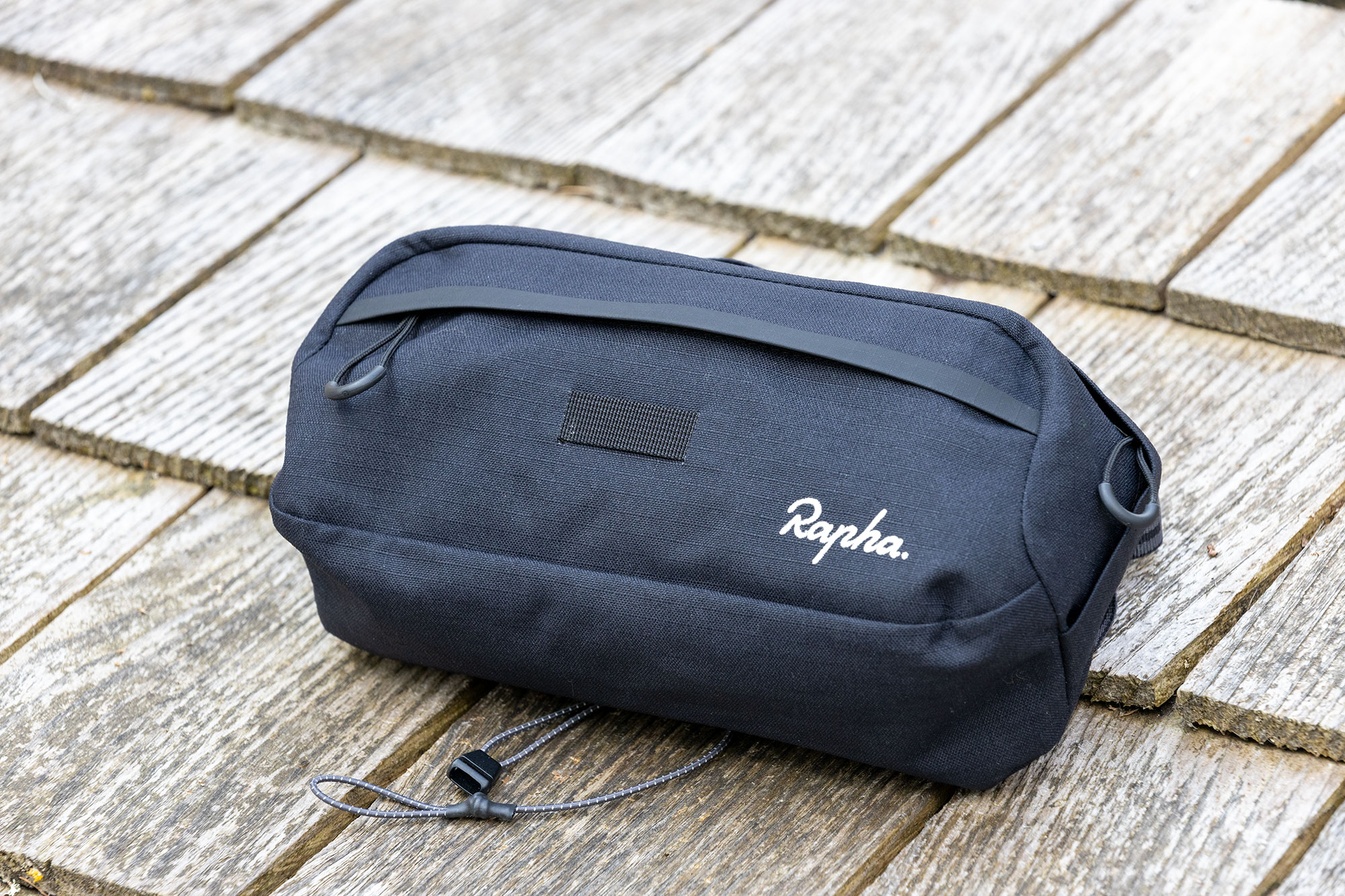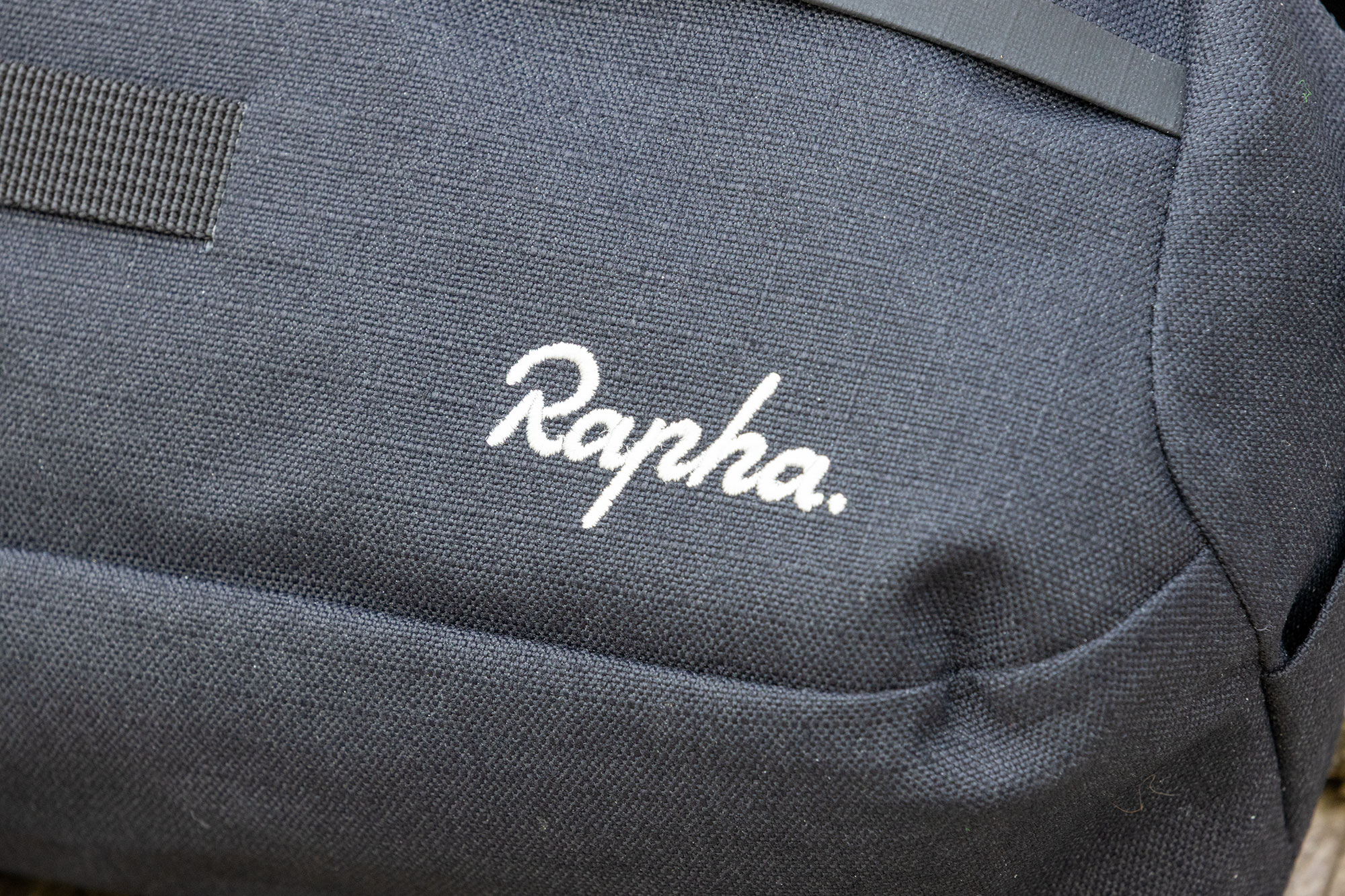
Small bar bags left me cold until, when kitting up for a tour of northern Spain and Mallorca in the summer of 2023, it dawned on me that I needed somewhere accessible to carry my passport, phone, multitool and a rain jacket both on and off the bike.
Yes, I could have gone down the traditional route of stuffing my rear pockets, but frankly, I’d rather have my eyeballs extracted without anaesthetic. What is it about cycling? No other pastime I can think of requires participants to tuck away the stuff they’re likely to need fast and frequently in a spot that’s both unreachable and unseeable. Yep, I’m no fan of largely inaccessible, small, sweaty rear jersey pockets, particularly on long rides.
The Explore Bar Bag readily converts into a cross-body or shoulder bag.
(Image credit: Future/Simon Fellows)
My Explore Bar Bag purchase, on the other hand, paid off handsomely. It carries more style kudos than bulging pockets and doubles up as a shoulder bag, making it super versatile, especially for travel. Hence the ‘explore’ moniker. It’s not a feature that many of the best handlebar bags have, either.
Unfortunately, it’s not all great news. Read on to discover whether your ride essentials are better off ‘in the bag’ or, despite my prejudice, ‘in the pocket’.
Construction

The bag is relatively modest in size, yet it offers substantially more stowage space than awkward-to-reach jersey pockets.
(Image credit: Future/Simon Fellows)
Measuring approximately 75mm x 120mm x 245mm, the Explore Bar Bag is relatively modest in size, yet it’s capacious enough to carry essentials for a day ride without overwhelming your handlebar real estate. Rapha doesn’t publish the bag’s capacity, but it’s about 2.3 litres by my back-of-the-envelope calculations.
The primary material is rugged ripstop nylon, which, with its pronounced texture and matt finish, could pass for a tightly woven canvas. It certainly feels both hard-wearing and robust. It’s PU coated on its inside face, and all major seams are taped, making it reliably water resistant.

My original bag that accompanied me across Spain, turned inside out to show taped seams and the elasticated webbing strip.
(Image credit: Future/Simon Fellows)
There are two zipped pockets: a main compartment that accounts for most of the bag’s capacity and a slim, no-frills pouch built into the front panel. The chunky plastic zippers are heavy-duty, but they’re not waterproof. However, each is concealed behind a storm flap to keep the worst of the weather at bay, and both have extended rubberised pull cords to ensure the sliders are easy to grab hold of.
The main compartment is quite spartan, with only a band of elasticated webbing to help organise its contents. The slim front pocket is completely featureless internally, but it boasts a small webbing strip on its outside face to hold a light or reflector. Additionally, the storm flap that conceals the front pocket is coated with a thin synthetic rubber strip to resist wear and add a touch of visual interest. On my black sample bag, the Rapha logo is neatly embroidered in white stitching in the lower right corner. Other colourways feature self-coloured embroidery for a more subtle look.

The rear panel, made of Hypalon, prevents scuffing and conceals the straps when they are not in use.
(Image credit: Future/Simon Fellows)
The Explore Bar Bag features three straps plus a short length of elasticated shock cord. A pair of narrow (200mm x 20mm) straps and corresponding plastic loops are securely stitched into the back of the bag, one top right and the other top left. It’s these straps, which are backed with self-engaging hook and loop, that fasten the bag to the bars. The shock cord then wraps around the head tube or headset spacers to reduce any unwanted movement.
The shoulder strap, which is much longer and slightly broader (1200mm x 25mm), converts the Explore Bar Bag into a cross-body bag or waist bag for off-bike use. It emerges from each side and fastens with a robust, adjustable, quick-release plastic clasp.
A sleek, soft Hypalon (synthetic rubber) rear panel elegantly conceals the stitching that permanently anchors all three straps to the bag and, in theory, protects your bike’s headtube from scratches. Vitally, the straps are supposed to be stowed behind the Hypalon panel when not in use.
The ride

The bag is relatively compact, so it doesn’t interfere with my hands when riding on the tops.
(Image credit: Future/Simon Fellows)
Attaching the Explore Bar Bag is child’s play, and I say that after trying it on a wide variety of bikes and bars. The process is so quick and easy that it elevates this bag above much of its competition. Hook and loop (commonly known as Velcro) makes for such a simple system that attaching or removing the bag takes me 30 seconds, if that. To hook up the bag, loosely secure one strap by threading it around the bar, through the plastic loop and back on itself, then repeat with the other strap. If necessary, adjust the bag’s final position before tightening both. Lastly, tie the shock cord around the stem or head tube. To remove the bag, simply reverse the process.
In my experience, the straps are long enough to mount this bag on most flat-topped aero road bars, as sacrilegious as that may sound to some. It will even piggyback on top of much larger bikepacking bags. Once in place, the bag is very secure, and the straps are low profile enough not to be too irksome. On my 42cm bars, it’s also small enough not to interfere much with my hands when riding on the tops.
Converting the bag from a bar bag to a shoulder bag is a little fiddly because it can take a while to stuff the two smaller straps behind the large Hypalon panel. Once the process is complete though, the result is both tidy and convincing. In shoulder bag mode, there’s little visual clue that this could be a bar bag and vice versa.
Loading it up is straightforward enough because it doesn’t present many options. The main compartment is my default place for kit – I rarely use the front pocket unless I’m carrying something slim, such as a passport, a Hiplok Z Lok or an additional pair of riding glasses for changing conditions. Talking of which, I’ve ridden with my Explore Bar Bag through everything from light showers to brief but heavy rainstorms, and the contents have remained dry. That said, I wouldn’t trust it to take a proper dunking or weather a prolonged deluge.

The zips are rugged and concealed by storm flaps, but are often frustratingly tricky to operate.
(Image credit: Future/Simon Fellows)
Why would anyone want a bar bag that readily doubles as a shoulder bag? Well, this bag is in its element during bike-packing breaks or off-road adventures. During my Spanish trip, it enabled me to stop at grocery shops, cafés and restaurants, safe in the knowledge that I could quickly grab my prized possessions to take with me. My passport, cash, cards, phone and more were always to hand, saving me having to rummage through my Tailfinn Aeropack or my frame bag. Small, accessible and contained – everywhere I went, on-bike or off, this modest bag and its valuable little payload went too.

The shoulder strap is wide enough but not quite long enough. It is secured with a quick-release clasp that has stood up to plenty of wear and tear.
(Image credit: Future/Simon Fellows)
It is, of course, suitable for more than just extended travel trips. I’ll rarely take it on very short rides, but if I plan to be out for a couple of hours or more it gets stuffed with a packable rain jacket, multitool, mini pump, spare tube, levers, phone and snacks. Its modest size and near instant deployment make it the perfect day pack. Well, almost.
Unfortunately, there is, quite literally, a snag. The zip for the main compartment can be a devil to open or close if you fail to get the two sides – tape or teeth – aligned. It seems to be luck of the draw, one day it will close with ease, the next it can take a good minute or two. Consequently, this is not a bag you’ll want to unzip during an active part of a ride, which will limit its use for some cyclists.
A more minor irritation is the shoulder strap length, which may be on the short side for taller cyclists. I’m 191cm tall and it’s just about OK as a cross-body bag.
Value and Conclusions

(Image credit: Future/Simon Fellows)
Bar bags will always be ‘Marmite’ products because, despite their positive attributes, they negatively influence a bike’s aerodynamics. What’s more, they spoil the lines of any drop-bar road bike.
If, however, you’re more concerned by practicalities than aesthetics, or value everyday functionality over out-and-out speed, then a small bag like this makes a lot of sense. Certainly, they’re a no-brainer for gravel riding and bike-packing.
Ortlieb’s 3-litre waterproof Velo-Sling is possibly the Explore Bar Bag’s closest competitor. It’s slightly larger, which may or may not be a good thing, fully waterproof and has a wide, removable strap that repurposes it as a shoulder bag. The closure system is magnetic too, making it much easier to open than the Explore Bar Bag. It is more expensive at £81/$95.
Apidura offers a similarly sized bag, the 2-litre Racing Handlebar Pack, for a fraction more at £70/$93. It doesn’t convert to a shoulder bag, but it is fully waterproof. Restrap’s characterful little 1.5-litre Cannister Bag shares some similarities with the Explore Bar Bag, but it doesn’t convert into a shoulder bag either. It is, however, waterproof and provides a cheaper alternative at £49.99/$74.99.
Zefal’s option, the 2.5-litre Z Adventure F2, is neither a shoulder bag nor is it fully waterproof, but it’s very affordable at €39.95.
To sum up, the Rapha Explore Bar Bag may carry a premium price, but its versatile, well-thought-out design offers an additional layer of functionality that few other bags can match. In my opinion, it’s also one of the more attractive small bags on the market. It’s such a shame the main zip lets it down.
Specs
- Material: Ripstop Nylon
- Dimensions (approx.): 75mm x 120mm x 245mm
- Capacity (approx.): 2.3 litres
- Weight: 165g

